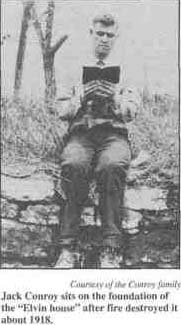Book Review 'Worker-writer' movement and Jack Conroy deserve literary recognition By JAMES R. GILES
Douglas Wixson. Worker-Writer in America: Jack Conroy and the Tradition of Midwestern Literary Radicalism, 1898-1990. Urbana: University of Illinois Press, 1994. Pp. 678 with notes, bibliography and index. $34.95 (cloth). Like most of the proletarian writers whom he helped and even sponsored during the 1930s, Jack Conroy was banished from the canon of American literature during the 1950s and is still a neglected figure. Which is certainly not as it should be. Conroy, as a novelist and even more as a patient and devoted editor, exerted a positive and lasting influence throughout one of the most turbulent decades in the history of American literature. In 1933 his classic proletarian novel, The Disinherited, was published. At the time this first novel was widely received as a major breakthrough in American working-class fiction and, after four decades of neglect, it is now finally being rediscovered. Highly autobiographical and quite episodic in structure, The Disinherited recounts the struggle of its protagonist, Larry Donovan, to survive economically and spiritually as he moves from coal mine and steel mill to tire plant and Midwestern farm. While the book ends with Donovan discovering his salvation in group protest and labor organizing, it avoids the formulaic didacticism of much 1930s proletarian fiction. Conroy also started three little magazines — Rebel Poet, The Anvil and The New Anvil — devoted to discovering and giving voice to as yet unknown worker-writers from across America, including Richard Wright and Nelson Algren, with whom he worked on the Writers' Project of the Works Progress Administration in Chicago; Meridel LeSueur, a journalist, labor reformer and fiction writer later banned during the McCarthy era; and Arna Bontemps, an African-American writer of fiction and non-fiction with whom Conroy co-authored several books. Douglas Wixson's book is a consistently fascinating study of the often painful and sometimes implausible details of Conroy's life and career up to the 1960s. It merely summarizes the relatively obscure and peaceful closing decades of the editor-novelist's long life, which ended in 1990. When one considers what Wixson is primarily interested in accomplishing, this structural imbalance is not an important limitation or weakness in his approach. Wixson emphasizes in his afterword that "{Worker-Writer} is not a biography in the traditional sense." It is, in fact, not the biography of a man, but of a literary movement, that of 1930s Midwestern worker-writer fiction; and it eloquently documents the struggles of the talented, colorful and, in most cases, ultimately defeated group of men and women who created it. Wixson resurrects such largely forgotten but invariably intriguing figures as Sanora Babb, Edward Falkowski, Joseph Kalar, Ruth Lechlitner, Joseph Vogel and W.W. Wharton. His account of the life and career of the wildly eccentric and deliberately provocative "farmer-poet of Missouri," H.H. Lewis, is, in itself, reason to read Worker-Writer in America. Wixson's decision to make Conroy the emblematic figure for this literary group is both an obvious and appropriate choice. Wixson offers a graphic account of the formidable obstacles they confronted. First, there was what he calls the "proletarian night" of the worker-writers, who had to attempt to produce convincing creative prose at night after working long, exhausting, sometimes dangerous and always boring jobs during the day. At least, that was their common problem when there wasn't a worse one — unemployment and the threat of homelessness. In addition, living in small towns or on farms in the Midwest, these ambitious young artists were locked out of any kind of creative community. One of Conroy's main gifts to them was a bridge over such isolation with outlets for their work like Rebel Poet and The Anvil. Still, as Wixson conclusively documents, the back of the Midwestern worker-writer movement was not ultimately broken by such immediate and practical concerns, but by orchestrated assaults from both the literary right and left. Conservative critical denunciation of Conroy, Lewis and LeSueur (and, for that matter, of Algren and Wright) was, from the first, extreme and unforgiving — the charge being that these proletarian writers were artistically crude and politically subversive. In the long run, however, much more devastating to the careers and reputations of the Midwestern worker-writers was their repudiation by the political and artistic left during the Popular Front years of the mid-'30s. Wixson ends Worker-Writer in America with a plea that the longstanding critical neglect of their contributions be corrected. He argues that "we need to continue the task of recovering 'disappeared' writers and clarifying neglected traditions. It may happen again that a generation of bright, young and energetic men and women, uprooted, without a future, helmless and homeless, hear the voices of 'those who do not write.'" His book represents an excellent beginning for such a worthy project. James R. Giles is professor of English at Northern Illinois University. He is the author of Confronting the Horror: The Novels of Nelson Algren (Kent State University Press, 1989). 30/October 1994/Illinois Issues
|
|||||||||||||||

